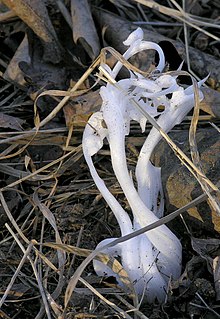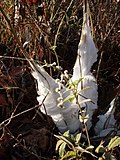| This article needs additional citations for verification. Please help improve this article by adding citations to reliable sources. Unsourced material may be challenged and removed. Find sources: "Frost flower" – news · newspapers · books · scholar · JSTOR (April 2010) (Learn how and when to remove this message) |

A frost flower or ice flower is formed when thin layers of ice are extruded from long-stemmed plants in autumn or early winter. The thin layers of ice are often formed into exquisite patterns, curling into "petals" which resemble flowers.
Types
Frost flower formations are also referred to as frost faces, ice castles, ice blossoms, or crystallofolia.
Types of frost flowers include needle ice, frost pillars, or frost columns, extruded from pores in the soil, and ice ribbons, rabbit frost, or rabbit ice, extruded from linear fissures in plant stems. The term "ice flower" is also used as synonym for ice ribbons, but it may be used to describe the unrelated phenomenon of window frost as well.
Formation
The formation of frost flowers is dependent on a freezing weather condition occurring when the ground is not already frozen. The sap in the stem of the plants will expand (water expands when frozen), causing long, thin cracks to form along the length of the stem. Water is then drawn through these cracks via capillary action and freezes upon contact with the air. As more water is drawn through the cracks it pushes the thin ice layers further from the stem, causing a thin "petal" to form.
The petals of frost flowers are very delicate and will break when touched. They usually melt or sublime when exposed to sunlight and are usually visible in the early morning or in shaded areas.
Examples of plants that often form frost flowers are white crownbeard (Verbesina virginica), commonly called frostweed, yellow ironweed (Verbesina alternifolia), dittany (Cunila origanoides), and Helianthemum canadense.
-
 Example of the hydraulic power of capilliary freezing
Example of the hydraulic power of capilliary freezing
-
Frost flower closeup
-
 Frost flower on a yellow ironweed stem in southern Missouri
Frost flower on a yellow ironweed stem in southern Missouri
-
 Frost flower on common dittany (Cunila origanoides) in NW Arkansas
Frost flower on common dittany (Cunila origanoides) in NW Arkansas
See also
References
- "Frost Flowers – different things – name conflict". my.ilstu.edu. Archived from the original on 18 November 2020. Retrieved 7 September 2020.
- "Missouri Conservationist Magazine Oct. 2000 issue". Archived from the original on 13 November 2017. Retrieved 12 November 2017.
- "Dittany". Missouri Department of Conservation.
- Carter, James Richard (September–October 2013). "Flowers and Ribbons of Ice". American Scientist. Vol. 101, no. 5. p. 360. doi:10.1511/2013.104.360. Retrieved 7 December 2022.
- Coblentz, William Weber (November 1914). "The exudation of ice from stems of plants". Journal of the Franklin Institute. 178 (5): 589–621. doi:10.1016/S0016-0032(14)90269-1.
- Means, D. Bruce (February 2004). "Blossoms of Ice: These delicate "flowers" sprout only in winter, but you won't find them catalogued in any herbal". Natural History. 113 (1): 36–37.
- Means, D. Bruce (January–February 2005). "Mysterious Ice 'Flowers'". American Gardener. pp. 34–8.
External links
| Ice | |||||
|---|---|---|---|---|---|
| The solid state of water | |||||
| Major phases | |||||
| Formations | |||||
| Phenomena | |||||
| Ice-related activities |
| ||||
| Constructions | |||||
| Work | |||||
| Other uses | |||||
| Ice ages | |||||
| |||||